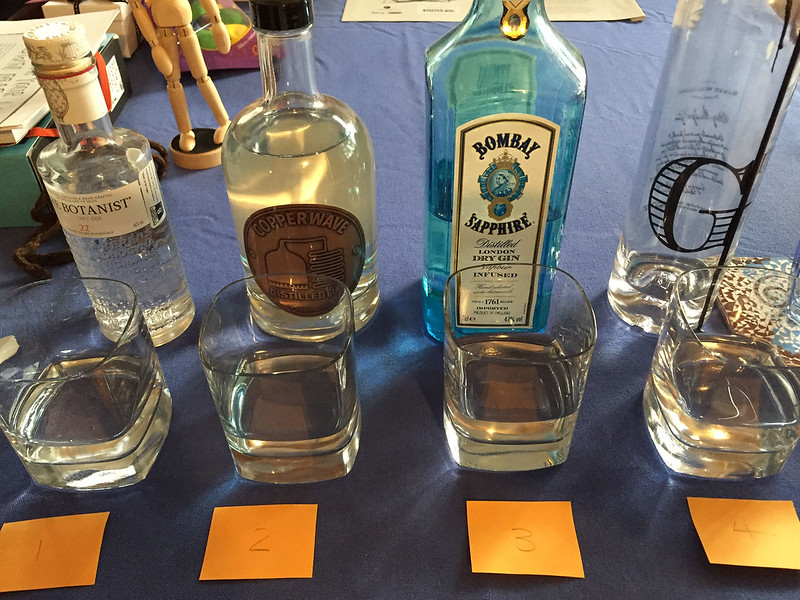With a couple of bottles of gin running low, I restocked with another couple of different brands. I realised I then had four different types of gin on hand – enough to do a taste and comparison test! So I recruited my wife to help me do a blind test. She poured a scant finger of each into four different glasses, and labelled them 1 to 4, without me knowing which was which. Then after I tasted them all, she revealed which was which. Here are my notes.
Procedure: I began with the aromas. I took a few sniffs of each glass, taking time to breathe clear air in between the different samples. After writing aroma notes, I took a sip of each gin, neat. In between each one I sipped water to clear the palate. Gin by itself is very strong, but it’s a good way to get the full effect of the flavours. After trying each one neat a couple of times, I added a small amount of soda (about 1:1 with the gin) to each and repeated the tastings. Finally, I added a good amount of soda to each, reducing it to about a 1:3 ratio – roughly what I’d normally mix for drinking. I didn’t use tonic, because (a) I think it would mask the flavours of the gin and (b) I normally use soda as my mixer because I don’t like the added sweetness of tonic.
Aromas: I tackle the glasses in numerical order. 1 is citrusy, with a hint of aniseed. 2 smells more spicy, with touches of cinnamon and aniseed. Number 4 reminds me of Earl Grey tea, with a bergamot aroma, and possibly also a hint of tea. Finally, 4 comes across as sweet, and also has a citrusy fragrance, but different to number 1. I peg 4 as more of an orange aroma, while 1 is more like lime when I return for another sniff. A second sniff of 2 also brings herbal smells. 2 is definitely the strongest smelling sample, with 3 the most subtle.
Neat sip: 1 has a very strong alcohol burn, and the flavour is mostly aniseed. 2 is much milder, and has a musky, floral taste, a little like musk sticks. 3 is strong again, and has a herbal flavour compared to the other two, with a touch of bitterness. 4 is milder once more, with flavours of orange peel and cloves.
1:1 soda: Adding soda opens up the flavours, removing the alcohol burn and making it easier to pick out more subtle notes. Although it doesn’t do much for number 1, which still only gives me an impression of aniseed – not as strong as ouzo or some other specifically aniseed liqueur. There is something else in there, but I’m struggling to give it a name so far. 2 remains determinedly floral in character – I don’t really like it, this is my least favourite so far. 3 becomes slightly woody with the soda, with hints of rosemary. This is a nice one with the herbal characters I like. Number 4 continues to remind me of orange peel, which is also positive and nice.
1:3 soda: In the final round, I finally peg what’s going on with number 1. It’s slightly smoky and earthy, almost a little bit like tyre rubber, and perhaps a hint of saltiness. Yeah, it’s smoky and salty, like a fire that’s been put out with sea water. This is my second least favourite. Number 2 is my least favourite. The floral aromas and tastes continue, muted now by the soda down to reminiscences of jasmine and lavender. 3 retreats a bit from woodiness to herbal, with the hint of rosemary remaining. 4 continues to impress orange peel, and now develops some herbal nature. I like 3 and 4 the best.
The reveal: My wife reveals the bottles associated with each glass:
- The Botanist – Islay, Scotland.
- Copperwave – Hunter Valley, Australia.
- Bombay Sapphire – London, England.
- Baker Williams – Mudgee, Australia.
Interesting! I’d bought a new bottle of Copperwave specifically because I’d enjoyed the first bottle I had – which was the first bottle of gin I’d ever bought. Maybe I didn’t enjoy it as much as I remembered, at least in comparison to some other brands. The Botanist is interesting – I know that Scotch whiskies from Islay are renowned for their smoky peatiness and hints of the sea (though I’ve yet to try any), and it seems as though they’ve captured the same sort of flavours in their gin. Bombay Sapphire I’d thought of as run-of-the-mill, compared to my initial bottle of Copperwave, but it rated well in this comparison. And finally the Baker Williams performed well in this test, matching my preferences nicely. I’ll have to see how each of these measures up in individual drinks later on.
I was amazed at how much variety and easily detectable difference there was between these four gins. Each one was so distinctive that I feel like I could very easily pick all four out of an anonymous line-up of just these four. I’ll be interested to make other comparisons of different gins in the future.
Tags: gin, taste test

